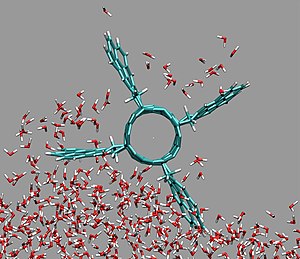Molecular propeller

Molecular propeller is a molecule that can propel fluids when rotated, due to its special shape that is designed in analogy to macroscopic propellers:[1][2] it has several molecular-scale blades attached at a certain pitch angle around the circumference of a shaft, aligned along the rotational axis.
The molecular propellers designed in the group of Prof. Petr Král from the University of Illinois at Chicago have their blades formed by planar aromatic molecules and the shaft is a carbon nanotube.[3] Molecular dynamics simulations show that these propellers can serve as efficient pumps in the bulk and at the surfaces of liquids. Their pumping efficiency depends on the chemistry of the interface between the blades and the liquid. For example, if the blades are hydrophobic, water molecules do not bind to them, and the propellers can pump them well. If the blades are hydrophilic, water molecules form hydrogen bonds with the atoms in the polar blades. This can largely block the flow of other water molecules around the blades and significantly slow down their pumping.
Driving[edit]
Molecular propellers can be rotated by molecular motors that can be driven by chemical, biological, optical and electrical means,[4][5][6] or various ratchet-like mechanisms.[7] Nature realizes most biological activities with a large number of highly sophisticated molecular motors, such as myosin, kinesin, and ATP synthase.[8] For example, rotary molecular motors attached to protein-based tails called flagella can propel bacteria.
Applications[edit]
In a similar way, the assembly of a molecular propeller and a molecular motor can form a nanoscale machine that can pump fluids or perform locomotion.[9] Future applications of these nanosystems range from novel analytical tools in physics and chemistry, drug delivery and gene therapy in biology and medicine, advanced nanofluidic lab-on-a-chip techniques, to tiny robots performing various activities at the nanoscale or microscale.
See also[edit]
References[edit]
- ^ J. Vacek and J. Michl, A molecular "Tinkertoy" construction kit: Computer simulation of molecular propellers, New J. Chem. 21, 1259 1997.
- ^ Simpson, Christopher D.; Mattersteig, Gunter; Martin, Kai; Gherghel, Lileta; Bauer, Roland E.; et al. (2004). "Nanosized Molecular Propellers by Cyclodehydrogenation of Polyphenylene Dendrimers". Journal of the American Chemical Society. 126 (10). American Chemical Society (ACS): 3139–3147. doi:10.1021/ja036732j. ISSN 0002-7863. PMID 15012144.
- ^ Wang, Boyang; Král, Petr (2007-06-28). "Chemically Tunable Nanoscale Propellers of Liquids". Physical Review Letters. 98 (26). American Physical Society (APS): 266102. Bibcode:2007PhRvL..98z6102W. doi:10.1103/physrevlett.98.266102. ISSN 0031-9007. PMID 17678108.
- ^ Kelly, T. Ross; De Silva, Harshani; Silva, Richard A. (1999). "Unidirectional rotary motion in a molecular system". Nature. 401 (6749). Springer Science and Business Media LLC: 150–152. Bibcode:1999Natur.401..150K. doi:10.1038/43639. ISSN 0028-0836. PMID 10490021. S2CID 4351615.
- ^ Koumura, Nagatoshi; Zijlstra, Robert W. J.; van Delden, Richard A.; Harada, Nobuyuki; Feringa, Ben L. (1999). "Light-driven monodirectional molecular rotor" (PDF). Nature. 401 (6749). Springer Science and Business Media LLC: 152–155. Bibcode:1999Natur.401..152K. doi:10.1038/43646. hdl:11370/d8399fe7-11be-4282-8cd0-7c0adf42c96f. ISSN 0028-0836. PMID 10490022. S2CID 4412610.
- ^ Bustamante, Carlos; Chemla, Yann R.; Forde, Nancy R.; Izhaky, David (2004). "Mechanical Processes in Biochemistry". Annual Review of Biochemistry. 73 (1). Annual Reviews: 705–748. doi:10.1146/annurev.biochem.72.121801.161542. ISSN 0066-4154. PMID 15189157.
- ^ Astumian, R. Dean (1997-05-09). "Thermodynamics and Kinetics of a Brownian Motor". Science. 276 (5314). American Association for the Advancement of Science (AAAS): 917–922. doi:10.1126/science.276.5314.917. ISSN 0036-8075. PMID 9139648.
- ^ Tsunoda, S. P.; Aggeler, R.; Yoshida, M.; Capaldi, R. A. (2001-01-30). "Rotation of the c subunit oligomer in fully functional F1Fo ATP synthase". Proceedings of the National Academy of Sciences. 98 (3): 898–902. Bibcode:2001PNAS...98..898T. doi:10.1073/pnas.98.3.898. ISSN 0027-8424. PMC 14681. PMID 11158567.
- ^ Soong, R. K.; Bachand, G. D.; Neves, H. P.; Olkhovets, A. G.; Craighead, H. G.; Montemagno, C. D. (2000-11-24). "Powering an Inorganic Nanodevice with a Biomolecular Motor". Science. 290 (5496). American Association for the Advancement of Science (AAAS): 1555–1558. Bibcode:2000Sci...290.1555S. doi:10.1126/science.290.5496.1555. PMID 11090349.
